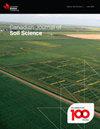在加拿大土壤分类系统有机阶的大群和亚群水平上更好地识别土壤物质
IF 1.5
4区 农林科学
Q4 SOIL SCIENCE
引用次数: 30
摘要
在加拿大土壤分类系统(CSSC)中,主要根据中间层的优势有机质对土壤进行大类群的分类。该系统识别出纤维层(of)、介质层(Om)、腐殖质层(Oh)和共生层(Oco)四种类型的有机层位,其中只有后者在有机目的大群水平上未被识别。此外,在亚群水平上,第三系亚群不可能有恐怖层或水合层。这在土壤中是有问题的,其中中层主要是石灰质物质,以及那些主要是石灰质物质和有一个可怕的层。我们描述了安大略省和魁北克省的29个土壤剖面,这些土壤剖面要么在CSSC中捕获得很差,要么无法根据其诊断标准归类为有机目。基于对加拿大5个省土壤调查资料的分析,我们估计有32057公顷的有机土壤可能含有石灰沉积。在魁北克的主要蔬菜产区,农业生产中的大型有机矿床受到泥炭沉降和侵蚀的影响,导致下伏共生土的深度较浅,这不是作物生产的合适介质。当在犁层中与腐殖质物质混合时,这可能对作物产生潜在的负面影响。基于这些分类学和农学上的考虑,我们建议增加一个新的类群Limnisol,并建议在亚群水平上进一步整合Humisol、Mesisol和Fibrisol类群的土壤材料。本文章由计算机程序翻译,如有差异,请以英文原文为准。
Better recognition of limnic materials at the great group and subgroup levels of the Organic Order of the Canadian System of Soil Classification
Abstract In the Canadian System of Soil Classification (CSSC), soils of the Organic order are classified at the great group level primarily based on the dominant organic material in the middle tier. The system recognizes four types of organic horizons: fibric (Of), mesic (Om), humic (Oh), and coprogenous earth (Oco), of which only the latter is not recognized at the great group level of the Organic order. Furthermore, at the subgroup level, Limnic subgroups cannot have terric or hydric layers. This is problematic in soils where the middle tier is dominated by limnic materials, and those which have dominantly limnic materials and have a terric layer. We describe 29 soil profiles in Ontario and Quebec, which are either poorly captured in the CSSC or that cannot be classified into the Organic order based on their diagnostic criteria. Based on an analysis of soil survey information in five provinces across Canada, we estimate 32057 ha of organic soils which potentially contain limnic deposits. In key vegetable-producing areas of Quebec, large organic deposits in agricultural production are subject to peat subsidence and erosion, resulting in shallower depths to underlying coprogenous earth, which is not a suitable medium for crop production. This can potentially have negative effects on crops when mixed with humic materials in the plow layer. Due to these taxonomic and agronomic considerations, we propose the addition of a new great group, Limnisol, and suggest further integration of limnic materials at the subgroup level for the Humisol, Mesisol, and Fibrisol great groups.
求助全文
通过发布文献求助,成功后即可免费获取论文全文。
去求助
来源期刊

Canadian Journal of Soil Science
农林科学-土壤科学
CiteScore
2.90
自引率
11.80%
发文量
73
审稿时长
6.0 months
期刊介绍:
The Canadian Journal of Soil Science is an international peer-reviewed journal published in cooperation with the Canadian Society of Soil Science. The journal publishes original research on the use, management, structure and development of soils and draws from the disciplines of soil science, agrometeorology, ecology, agricultural engineering, environmental science, hydrology, forestry, geology, geography and climatology. Research is published in a number of topic sections including: agrometeorology; ecology, biological processes and plant interactions; composition and chemical processes; physical processes and interfaces; genesis, landscape processes and relationships; contamination and environmental stewardship; and management for agricultural, forestry and urban uses.
 求助内容:
求助内容: 应助结果提醒方式:
应助结果提醒方式:


